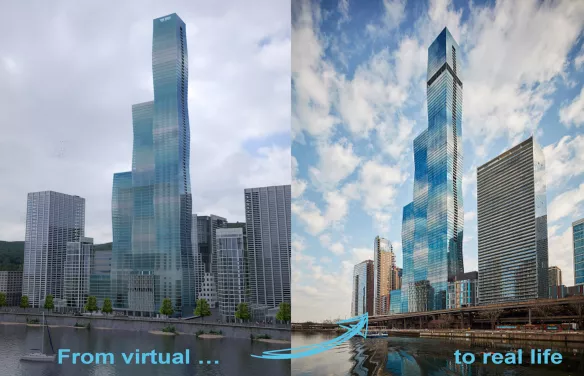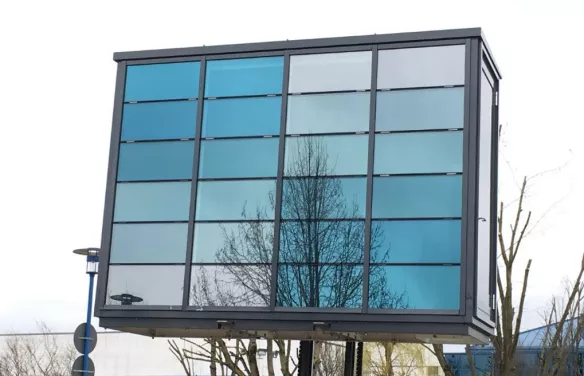It only took three days! On day 1 we selected the desired tints via a rendering engine with a calibrated screen. On day 2 we looked at actual glass samples that were produced overnight. And the next morning we were able to review IGU’s of transparent and spandrel panels that had been mocked up for us. The knowledgeable staff and speedy turnaround at AGC were very impressive and effective.
The St. Regis Chicago is now the third tallest building in the Chicago skyline with its 3 interconnected towers and is considered as “the most important addition to the Chicago skyline in a generation” by the Wall Street Journal. The project houses residential units, a 5-star hotel and restaurants.
The glass façade of the St. Regis Chicago works in tandem with its unique form of nested, undulating stems to reinforce the tower’s flowing appearance while also tuning environmental performance in response to differing floor-to-glazing ratios. Levels with smaller floorplates have darker, higher-performing glass on their facades to control solar heat gain. Reciprocally, levels with larger floorplates are paired with clearer glass.

“We sought glass that could not only vary in the necessary level of solar heat mitigation, but also whose shades of blue-green could produce a smooth gradient across the building’s façade in ways that accentuate the flowing form of the building.”
The façade’s design is driven by the building’s relationship to its broader urban and ecological context. At a macro-level, the building is lifted to create a pedestrian passageway from the Lakeshore East community to the newly-revitalized Chicago River. When viewed from afar, the tower appears to undulate, which is achieved by straight panels of glass which step in or out by only 5 inches per level, a move that helps to reflect the tones of the sky without using a highly reflective glass.
Juliane Wolf pursues: “When working on the St. Regis Chicago, we initially thought that we could achieve the gradient façade with glazing products already available on the market. We tested many options with different glass fabricators available on the US market, but none were able to produce the desired effect using their off-the-shelf colors. We found that the complexity of variables in the production processes prohibited a regular color gradient among the six types of glass needed for the different floor sizes.
We actually had been aware of AGC’s Coating on Demand (COD) technology for a while so we connected back and found out the technology can actually be scaled up quite easily to the size of a tower, which made the collaboration possible.”
Studio Gang’s design team and project ownership traveled to Germany to work closely with the AGC team to identify and select the glass. They spent time together digitally modeling, creating construction mock-ups, and testing batches in the factory, ultimately resulting in the six different types of glass that met their needs for the project.

“It only took three days! On day 1 we selected the desired tints via a rendering engine with a calibrated screen. On day 2 we looked at actual glass samples that were produced overnight. And the next morning we were able to review IGU’s of transparent and spandrel panels that had been mocked up for us. The knowledgeable staff and speedy turnaround at AGC were very impressive and effective.” She remembers.
“The gradient of the glass is an essential component of our building’s design and people’s experience of it, and we would not have been able to realize our ambitions without this technology. We are proud to have designed one of the first and largest applications of this new technology in North America!”

The building, which is now the third tallest in Chicago, was named one of the best new buildings of 2021 by the Council on Tall Buildings and Urban Habitats and called “easily the most important addition to the Chicago skyline in a generation” by the Wall Street Journal. Chicagoans have reacted positively to the way the glass appears to subtly ripple, picking up the hues of the nearby Lake Michigan and the ambient textures of surrounding buildings.
“We are very happy with the Coating on Demand service provided by AGC. Seeing it full scale in in its final form is very rewarding. As we had hoped, the gradient accentuates the building’s flowing form and is a major part of the design. Delivery of the glass went smoothly in spite of global construction and supply chain challenges. One aspect of the glass that has been particularly successful to inhabitants is that the tint reads much more subtly from the interior, so their views appear nearly clear. This directionality of the glass is another aspect that is contributing to the success of the application.”

